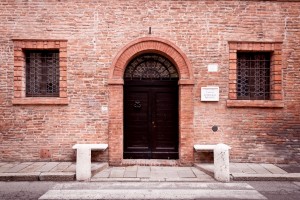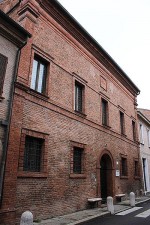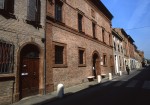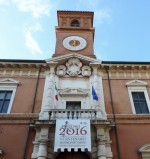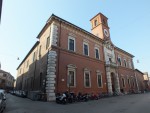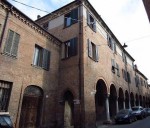Ludovico Ariosto's House
Purchased by the Poet in 1526, the house, complete with land and a garden, hosted Ariosto in the last years of his life, until 1533, the year of his death. In 1815, it was acquired by the Municipality, which designated it as a cultural venue.
Property of Ludovico Ariosto
After spending three years in Garfagnana with the appointment of Governor entrusted to him by Duke Alfonso d'Este, Ariosto nurtures the desire to retire to a quiet life to focus on his delicate health and take care of his family. He wanted to enjoy a more tranquil domestic setting where he could indulge in the everyday with his beloved Alessandra Benucci after suffering the long separation of years in Garfagnana.
Ludovico Ariosto purchases, through a deed dated 30 June 1526, drawn up by the notary Ercole Pistoia, the residence in Contrada del Mirasole sold to him by Bartolomeo Cavalieri. The building stood in an area immersed in greenery at the time known as "Aeranuova," enclosed within the city walls of 1492.
E credo che sia quanto minor fallo
Che di farmi pagar, s’io raccomando
Al principe la causa d’un vassallo;
o mover liti in benefici, quando
ragion non v’abbia, facciami i pievani
ad offerir pension venir pregando.
Anco fa che al ciel levo ambo le mani,
che abito in casa mia comodamente,
voglia tra cittadini e tra villani;
e che nei ben paterni il rimanente
del viver mio, senza imparar nova arte,
posso e senza rossor, far, di mia gente.
Ma perché cinque soldi da pagarte,
tu che noti, non ho, rimetter voglio
la mia favola al loco onde si parte.
Aver cagion di non venir mi doglio:
detto ho la prima, e s’io vuo’ l’altre dire,
né questo basterà né un altro foglio.
Pur ne dirò anco un’altra:che patire
Non debbo che, levato ogni sostegno,
casa nostra in ruina abbia a venire
(Sat.I, 184-189)
Ariosto personally took care to make some modifications to the house to make it closer to his idea of a family retreat and entrusted the work to the designs of Girolamo da Carpi (1528). He acquired adjacent land to the residence, extending all the way to the church of San Benedetto, to be used as a garden and orchard which he tended to until the end of his days. In this abode, Ariosto, assisted by the loving care of his son Virginio and comforted by the affection of Benucci, dedicated himself to the third and final expanded version of the Orlando Furioso (1532), and here he passed away on July 6, 1533.
"Parva domus"
On the facade is affixed the famous inscription that was already present on the building before Ariosto purchased it and which he decided to maintain because it suited the nature of the place: "Parva sed apta mihi, sed nulli obnoxia sed non sordida, parta meo sed tamen aere domus" ("small but suitable for me, subject to none and built with my money"). The modesty of the abode befitted the character of the Poet, who was never inclined to solicit favours from the Court for whom he worked “such that, by building in Mirasole, it was obtained from the Duke- who sometimes gave away buildings with great nonchalance! - just a bit of stones” (Pazzi 1929, p. 308), referring to the lack of extravagance by Alfonso I towards him.
A second terracotta plaque, placed by his son Virginio, bears an auspicious inscription: "Sic domus haec Ariosta propizio, deos habeat ut pindarica"("May this house of the Ariostos have gods as propitious as those of Pindar's"). The two inscriptions summarise some of the fundamental elements in Ludovico Ariosto's life: the deep desire for tranquillity, affection for his loved ones, and the need for secure and balanced places. To these is added the faith in the freedom of imagination, creative and poetic.
Quotes
‘Today is a very important day for us, I'd even call it historic, because it is imbued with meaning. We are inaugurating the Ferrara headquarters (our offices in Codigoro remains alive and active, a point that must be stressed). We are thus opening the Ferrara branch of the Giorgio Bassani Foundation, an entity that our father deeply hoped for since the 1980s, and that my brother Enrico and I, to satisfy his wishes, created in 2002 (16 years ago). We did so gradually with the help of a few of our family members and some close friends of ours and of our father, and, more generally, thanks to the help of many illustrious representatives from the world of culture, but also thanks to the generous support of the Ministry for Cultural Heritage (MIBACT), the Fondazione Cassa di Risparmio of Ferrara, and the Region of Emilia-Romagna. In the rooms of Casa Ariosto, we have finally reunited most of the materials (the heritage of the Giorgio Bassani Foundation) that had been scattered about up until now (between the MEIS, the University of Ferrara, Rome, the home of our mother and the home of Mirella Haggiag - here I cannot stress enough, full of gratitude, how lovingly and carefully those materials have been stored in each of those places). ...The house of Ludovico Ariosto is an ample, quiet, well-equipped space, where it will be possible to properly welcome scholars and fans of Giorgio Bassani, and organise different activities (conferences, conventions, exhibitions, performances, projections, etc.) Casa Ariosto: the home where the great poet of ‘Orlando Furioso’ lived, the home described by him in an inscription on the façade: ‘parva sed apta mihi’, ‘small but suitable for me’. Thus, a house neither too big nor too small, a comfortable home, middle class, half in the city and half in the countryside, placed the right distance from the court, from the world of dukes and dames - in short, a home where Ariosto could feel truly free, truly himself. Our father also always sought out houses that were suitable to him, in which he could work and feel free. And this house, inhabited five centuries ago by Ludovico Ariosto, couldn’t be a more worthy and meaningful place to accommodate Giorgio Bassani today (lacking, unfortunately, the now-lost house where he was born). Giorgio Bassani absolutely loved Ariosto, he surely was one of his great literary role models. It was from Ariosto that he learned to process the subjects of his tales with a certain irony, contemplating it from afar (Ariosto considered his own subject, the world of emperors and kings, from the moon, Bassani considered his own material, Ferrara, from Rome). But there’s more: Ludovico Ariosto and his house became the protagonists of a story by Bassani, a quick, powerful tale written in 1950 titled ‘Ludovico Ariosto and Alessandra Bonucci’, that in some way prefigured ‘The Stroll before Dinner’. The latter is a longer story that is part of Five Stories of Ferrara (1956) in which the protagonist, Elia Corcos, whose house is also halfway between the city and countryside, is taken up again and mixed with that of Ariosto, outlined in the former story from 1950.’ (Excerpt from Paola Bassani's speech from the inauguration of the House of Ludovico Ariosto as the Ferrara headquarters of the Giorgio Bassani Foundation, Ferrara, 13 April 2018.
The architecture
The building appears as a simple construction from the early 16th century. It features a balanced distribution of architectural elements and lacks any ornamentation, indicating a preference for that style characterized by a proportional distribution of outdoor and indoor spaces and a cleanliness of ornamental elements. This style emerged after the death of Biagio Rossetti in 1516, as desired by Alfonso I d'Este, and of which the painter and architect Girolamo Carpi (1501-1556) was one of the major interpreters in Ferrara.
"The sober two-story palazzetto, with a facade originally almost certainly painted and with well-regulated and simple planimetric ratios between the different internal and external spaces (house, courtyard, rustic annexes, orchard), indeed deviates, with subtle nonchalance, from similar late fifteenth-century and Rossettian experiences to recreate new spatial articulations and expressive connotations" (Ceccarelli, in Bentini, Una corte nel Rinascimento 2004, p. 139). The entrance portal is flanked by two marble seats, a gesture of the Poet to alleviate the discomfort of waiting for those who came to visit him.
Branch of the Giorgio Bassani Foundation
On Friday, 13 April 2018, the House of Ludovico Ariosto was inaugurated as a branch of the Giorgio Bassani Foundation. The foundation was established with prefectorial decree on 8 April 2002 with the mission of honouring the beloved writer, who passed away in Rome on 13 April 2000, and keeping his memory alive in Italy and abroad. The foundation promotes research and cultural events dedicated to Bassani and his life's work, literature and otherwise, thereby respecting the wishes expressed in his will. As of 4 April 2002, the foundation was housed in one of the rooms of the Municipal Library of Codigoro, the city and setting of Bassani's novel The Heron. The death of Valeria Sinigallia Bassani, the author’s widow, on 1 December 2013 made it necessary to find a larger location for the numerous volumes of the Bassani Library, which were already part of the foundation's catalogue, though safeguarded at the family's home at 1 Via Cisterna del Follo. That necessity gave rise to an agreement between the Municipality of Ferrara and the Giorgio Bassani Foundation, signed on 28 October 2016. This agreement provided three rooms on the ground floor of the Home of Ludovico Aroiosto as the new location of Bassani's collection of books. The home also became the Foundation's operational headquarters, while the structure in Codigoro remains its legal headquarters. The rooms on the ground floor of 67 Via Ariosto include a reconstruction of Giorgio Bassani's studio in Rome, with his typewriter and personal and professional memorabilia; a portrait of the author completed by Franco Gentilini in 1947 (recently restored); a copy of Paesaggio di Spina by Mimì Quilici Buzzacchi donated by the Quilici heirs to the Bassani Foundation on 17 November 2018; the author's personal library of 4,000 books (including those of his childhood education, some passed down by his maternal grandfather Cesare Minerbi, and those from secondary school); the literary archives, which include over 10,000 pages of manuscripts, typewritten documents, awards and honours; documents relating to his activities as President of Italia Nostra; and even letters, photographs and a family album. Made available by his children, Paola and Enrico Bassani, scholars can consult the materials upon request.
Bibliography
- Giovan Battista Pigna, I romanzi di M. Giouan Battista Pigna, al S. Donno Luigi da Este vescovo di Ferrara divisi in tre libri, Vincenzo Valgrisi, Venezia 1554
- Gianna Pazzi, Ferrara antica e Ferrara d'oggi (1000-1927), Lunghini & Bianchini, Firenze 1929
- Antonio Frizzi, Memorie per la storia di Ferrara, Francesco Pomatelli, Ferrara 1971
- Raffaele Belvederi, Virgilio Ferrari, Arturo Malagù, Ferrara e l'Ariosto. La Ferrariae Decus nel V centenario della nascita del poeta, SATE, Ferrara 1974
- Ludovico Ariosto, Cesare Segre, Satire e Lettere, Einaudi, Torino 1976
- Antonio Panizzi, Alessandro Marcigliano, La vita di Ariosto, Atti della Deputazione Provinciale Ferrarese di Storia Patria, SATE, Ferrara 1988
- Francesco Ceccarelli, Principi, città e architettura. Ferrara nel Cinquecento, in Jandranka Bentini (a cura di), Gli Este a Ferrara. Una corte nel Rinascimento, Silvana Editoriale, Milano 2004
Sitography
- http://servizi.comune.fe.it/attach/artistife/docs/libro_passeggiando.pdf
- http://www.ferraraterraeacqua.it/it/ferrara/scopri-il-territorio/arte-e-cultura/ville-dimore-teatri-storici/casa-di-ludovico-ariosto
- http://www.artecultura.fe.it/73/casa-di-ludovico-ariosto
- http://www.cronacacomune.it/notizie/33411/la-fondazione-giorgio-bassani-inaugura-la-sede.html
- https://www.fondazionegiorgiobassani.it/
- http://www.ferraraterraeacqua.it/it/ferrara/scopri-il-territorio/arte-e-cultura/biblioteche-storiche/fondazione-giorgio-bassani
- http://www.cronacacomune.it/notizie/35021/unopera-di-mimi-quilici-dono-dagli-eredi-alla-fondazione-bassani.html
- https://www.youtube.com/watch?v=XLGjLZMuW-U
Fototeca
Related places
Related Itineraries
Compiling entity
- Assessorato alla Cultura e al Turismo, Comune di Ferrara
Author
- Stefania De Vincentis
- Barbara Pizzo

